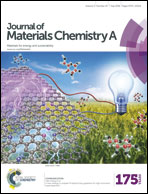3-D binder-free graphene foam as a cathode for high capacity Li–O2 batteries†
Abstract
To provide energy densities higher than those of conventional Li-ion batteries, a Li–O2 battery requires a cathode with high surface area to host large amounts of discharge product Li2O2. Therefore, reversible formation of discharge products needs to be investigated in Li–O2 cells containing high surface area cathodes. In this study, a binder-free oxygen electrode consisting of a 3-D graphene structure on aluminum foam, with a high defect level (ID/IG = 1.38), was directly used as the oxygen electrode in Li–O2 batteries, delivering a high capacity of about 9 × 104 mA h g−1 (based on the weight of graphene) at the first full discharge using a current density of 100 mA ggraphene−1. This performance is attributed to the 3-D porous structure of graphene foam providing both an abundance of available space for the deposition of discharge products and a high density of reactive sites for Li–O2 reactions. Furthermore, the formation of discharge products with different morphologies and their decomposition upon charge were observed by SEM. Some nanoscaled LiOH particles embedded in the toroidal Li2O2 were detected by XRD and visualized by TEM. The amount of Li2O2 formed at the end of discharge was revealed by a titration method combined with UV-Vis spectroscopy analysis.



 Please wait while we load your content...
Please wait while we load your content...